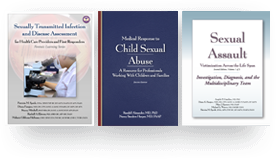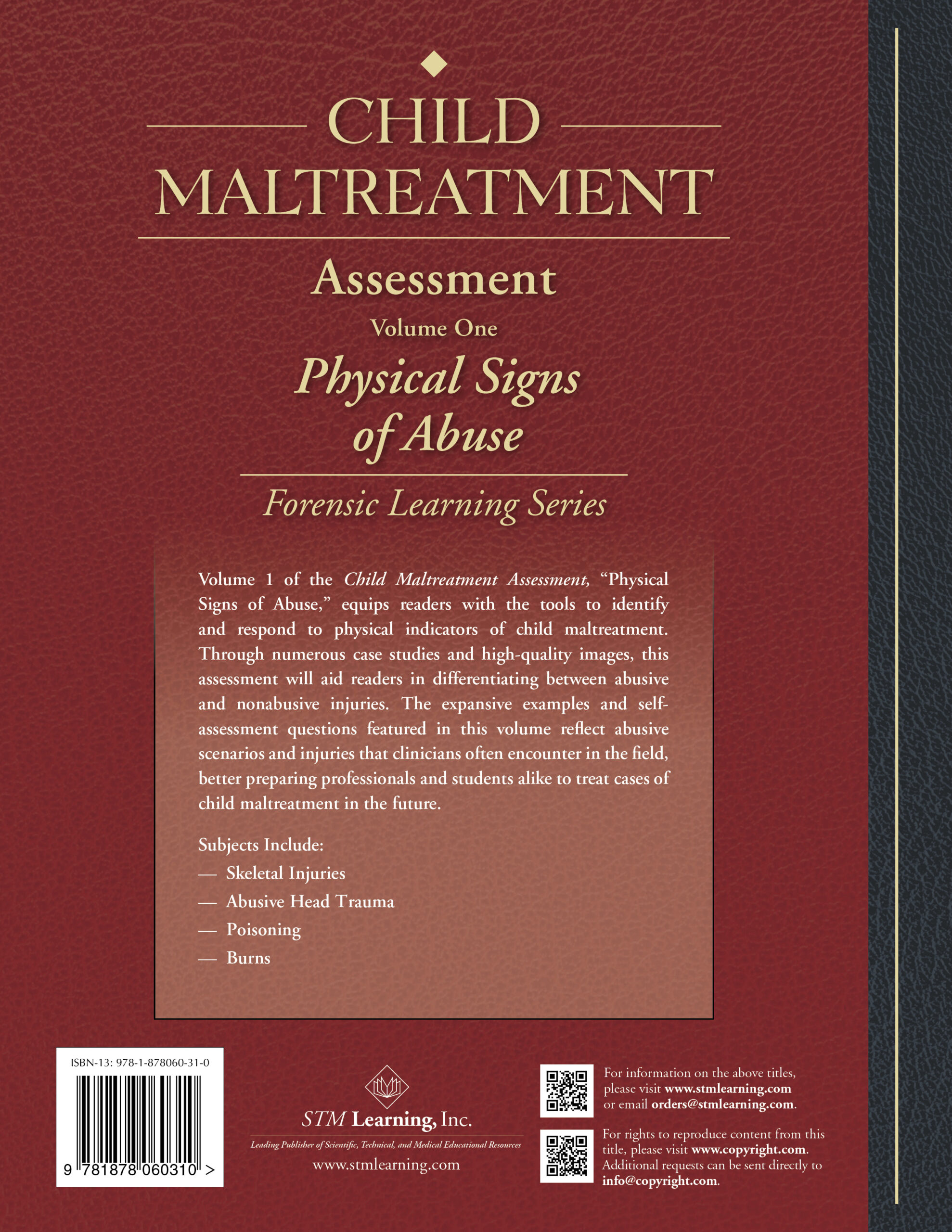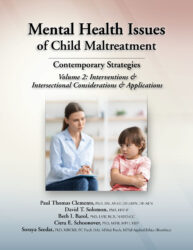Table of Contents
Volume 1: Physical Signs of Abuse
Section I: Definitions
Section II: Informational Chapters
1. How to Approach Suspected Physical Abuse
2. Skeletal Injuries
3. Sentinel Injuries
4. Thoracoabdominal Injuries
5. Abusive Head Trauma
6. Poisoning
7. Burns
Section III: Photographic Atlas
Section IV: Test Questions
Section V: Answer Key
Volume 2: Sexual, Emotional, and Psychological Abuse
Section I: Definitions
Section II: Informational Chapters
1. Child Sexual Abuse
2. Sexually Transmitted Infections
3. Munchausen Syndrome by Proxy
4. Neglect and Abandonment
5. Psychological Maltreatment
6. Torture
7. Psychopathology of Child Maltreatment
8. Treatment and Therapy
Section III: Photographic Atlas
Section IV: Test Questions
Section V: Answer Key
Volume 3: Investigation, Care, and Prevention
Section I: Definitions
Section II: Informational Chapters
1. The Role of Law Enforcement in the Investigation
of Child Maltreatment
2. The Review Process and Child Fatality Review
Teams
3. The Role of the Medical Examiner in Child Fatality
Investigations
4. Legal Issues
5. Testifying
6. Evidence-Based Treatment for Maltreated Children
7. Preventing Child Maltreatment
Section III: Photographic Atlas
Section IV: Test Questions
Section V: Answer Key
The Child Maltreatment Assessment series, a new 3-volume-workbook series should be a welcomed addition to both individual and institutional libraries as an authoritarian compendium that promises to be an invaluable resource for health care professionals as well as the disciplines of child protection, mental health, and law enforcement. The chapters that I had the pleasure of reviewing were thorough, well-written, and provided an easy-to-understand overview of complicated topical issues. The integration of a case-based format should in turn be of great practical value to the reader. There should be little doubt that the distinguished editors, Drs. Debra Esernio-Jenssen, Randell Alexander, and Ruchita Doshi have artfully selected both traditional and emerging topics contributed by well recognized authorities in the field. I look forward to adding this text to my library.
Martin A. Finkel, DO, FAAP
Professor of Pediatrics
Child Abuse Research Education & Service (CARES) Institute
Rowan University
Glassboro, New Jersey
The occurrence of child maltreatment remains a pervasive public health challenge. Often, children remain as “invisible victims” who live in the shadow of their abuse and neglect. As such, it is imperative for clinicians to understand the foundational facets of targeted and sensitive assessment, as well as appropriate intervention and referral. Children, as they rapidly move through growth and development, require the clinician to provide trauma related care that is age appropriate and that promotes on time bio-psycho-social progression. This textbook provides a multidimensional and interdisciplinary approach toward increased awareness, expanded assessment, and recommendations for treatment for this very vulnerable population of children. Additionally, the strategic use of case studies in the Photographic Atlas section provides for the ability of the reader to immediately translate the provided information toward enhancing safe and effective clinical practice. Child Maltreatment Assessment provides a solid foundational overview of the significant facets of assessment along the continuum of identification of child abuse and implementation of related strategies for safety and integration of the trauma. This is an excellent addition to any clinician’s library of resources.
Paul Thomas Clements, PhD, RN, ANEF, DF-AFN
Professor in Residence
University of Nevada, Las Vegas
Distinguished Fellow, Academy of Forensic Nursing
This text provides thorough, start-to-finish approaches for all professionals that work with children who have experienced maltreatment. It is clear that Drs. Esernio-Jenssen, Alexander, and Doshi intentionally set the stage for authors to present traditional and novel evidence-based information related to the etiology, prevention, treatment, and reporting of various types of abuse. These authors comprehensively consider the short- and long-term effects of maltreatment, including what we now know about the neurobiology of trauma, all while addressing strategies to provide patient- and family-centered care. In addition, and unique to this text, chapters provide case studies and photographs for discussion that clearly depict authentic situations and lead to deeper understandings of realistic practice implications. This assessment is a must-read for all who aim to remedy the epidemic of child maltreatment!
Sara Jones, PhD, APRN, PMHNP-BC, FAAN, FAANP















